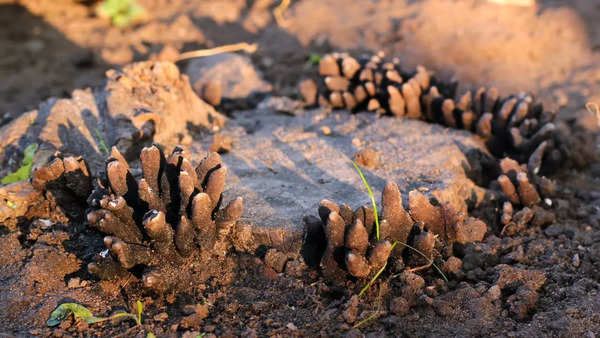
Representative images
Xylaria polymorpha is characterized by its dark, elongated fruiting bodies that can often be seen poking up through the ground in small clusters. These structures, which give the fungus its common name, are typically 1-3 cm in diameter and can grow to be 3-8 cm tall. When young, the fungus sports a white color, but as it matures, it turns a striking black, enhancing its finger-like appearance.
This fungus is found in various parts of the world and is not limited to any single continent, making it a cosmopolitan species. It is commonly spotted in the vicinity of stumps of dead trees or decaying wood, with a preference for hardwoods such as beech, maple, locust, elm, and apple trees. However, it is versatile enough to also grow on stressed ornamental trees and shrubs.
The biology of Dead Man’s Fingers is fascinating. Each ‘finger’ is a reproductive structure, with a small hole at the top that releases spores into the environment. These spores will then go on to colonize new substrates, continuing the life cycle of the fungus. The rot associated with Xylaria polymorpha is a soft rot, which usually does not pose a significant threat to the structural integrity of the wood it inhabits.
Despite its somewhat morbid appearance, Dead Man’s Fingers is not a pathogen of healthy trees. It is considered a weak pathogen that only attacks trees already under stress from other factors. Therefore, the presence of this fungus is often an indicator of underlying issues with the tree’s health.
Management of Xylaria polymorpha involves proper identification and monitoring. If the fungus is found growing from the trunk or roots of a tree, it may indicate that the tree is stressed and requires attention. While the presence of Dead Man’s Fingers does not necessitate immediate tree removal, it does call for regular inspection to assess the rate of decay and the overall health of the tree.
The appearance of Dead Man’s Fingers in nature emphasizes the complex and often unseen processes that occur within ecosystems. As a saprotrophic fungus, Xylaria polymorpha plays a vital role in breaking down dead organic matter, making it an essential component of the forest floor’s recycling system.
Dead Man’s Fingers is a remarkable organism that captures the imagination with its unusual appearance. It is a clear example of nature’s ability to specialize and adapt, fulfilling a specific role in the environment while sparking curiosity and wonder in those who encounter it.
Canada: Indian Student Shot Dead In The Same City Where Nijjar Was Killed; Probe Begins

